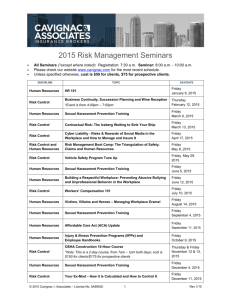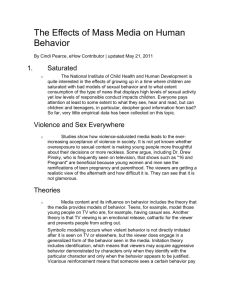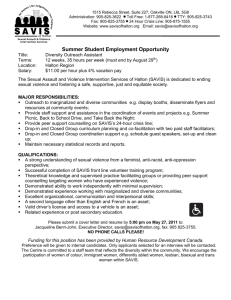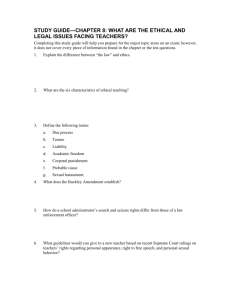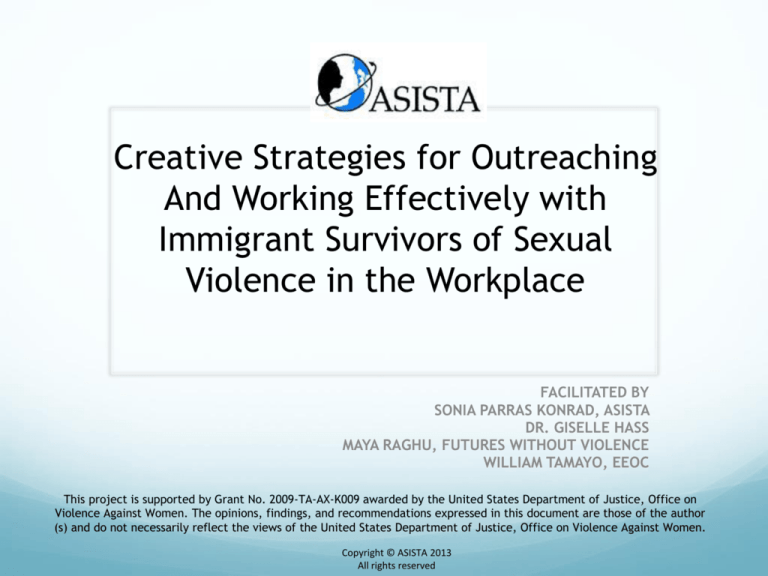
Creative Strategies for Outreaching
And Working Effectively with
Immigrant Survivors of Sexual
Violence in the Workplace
FACILITATED BY
SONIA PARRAS KONRAD, ASISTA
DR. GISELLE HASS
MAYA RAGHU, FUTURES WITHOUT VIOLENCE
WILLIAM TAMAYO, EEOC
This project is supported by Grant No. 2009-TA-AX-K009 awarded by the United States Department of Justice, Office on
Violence Against Women. The opinions, findings, and recommendations expressed in this document are those of the author
(s) and do not necessarily reflect the views of the United States Department of Justice, Office on Violence Against Women.
Copyright © ASISTA 2013
All rights reserved
GOALS
1. To raise awareness about sexual violence in the
workplace against immigrant women and how to
start talking about it with survivors
1. Present tips for working with traditional and nontraditional partners
2. Introduce state and federal basic legal remedies
available
IMMIGRANT WOMEN WORKERS
Occupations of Immigrant Workers
Overall, immigrant workers represent an especially
large share of the total U.S. labor force in two major
areas:
Private household services (42%)
Farming, Forestry & Fishing (37%).
Looking only at low-wage immigrants, the share is 44% in each
of the above major labor areas.
CCN Report – Undocumented workers make up about
5% of the U.S. labor force and are concentrated in
construction, agriculture and cleaning jobs.
36% of all insulation workers
29% of all agricultural workers
29% of all roofers.
Source: Urban Institute, Immigration Studies Program, November 2003; CNN Report
Female, Low-Wage Workers
in the U.S.
Overall, women make up 40% of the immigrant
workforce:
In the low-wage labor force, women make up 44% of low-wage,
foreign-born workers
Amongst undocumented workers, women comprise 32% overall
and 37% of low-wage undocumented workers
Per an EEOC report, crop production employs the
largest percentage of Hispanic women (18.5%) and the
largest percentage of total Hispanics (61.8%).
Source: Urban Institute, Immigration Studies Program, November 2003; EEOC report on
«Women of Color: Their Employment in the Private Sector», July 2003.
Immigrants Face Vulnerabilities in all
Phases of immigration
Immigrants, especially women, are vulnerable to
violence during all phases of migration:
At home
When being recruited for migrant work
While in transit
And, once in the destination country – at work
Why?
Sexual violence in the workplace is fostered by an imbalance of
power between employers, supervisors and their low wage
immigrant workers-Human Rights watch- cultivating fear Power: to hire or fire, retaliate and/or confer certain “benefits”
Immigrant women are extremely vulnerable
Immigrant women often face systemic barriers exacerbated by
their status as blue collar workers, often unauthorized to work
will NOT report these abuses nor bring perpetrators to justice
Sexual violence or sexual harassment?
Sexual harassment is a form of sexual violence and
gender violence
Sexual harassment must be addressed immediately
and seriously because it is often a precursor to sexual
violence in the form of rape
Immigrant survivors report that supervisors or coworkers perpetrators had harassed and abused them
multiple times before completing a rape during a period
of time
Do women reach out?
De Coster Iowa Farms
Women reach out because of immigration fears and other
victimization issues Women had been harassed for months
and then raped on a weekly basis
Women reported:
Incidents of ongoing debilitation humiliating sexual
harassment
They worked in isolation and were easy prey
Whose Business is it Anyway?
• Postville Raid
– Stumbling into victims by chance
– Olivia’s story
– Allegations of survivors
– Feeling like “cattle”
– Partnering to enter and exit the lines of work
– Wearing double panties and sweatpants
– Constantly touched sexually by line supervisors
– Assaulted sexually by men and women supervisors
Whose Business is it Anyway?
Sexual assault programs are the experts on providing
services to victims of sexual assault
Challenges: victims may not know their role and how
they can help, services are overwhelmed by the numbers
served and the scarce resources,
Whose Business is it Anyway?
SA programs
- Fewer resources
- Lack of access to workplaces
- “That is not part of my
grant…”
- No direct connection or
partnership with EEOC, Fair
Agencies, Workforce
development, employment
attorneys, unions etc
Survivors
Lack knowledge about
the services
Concerned about losing
their jobs if reporting
Concerned about being
deported if brought to
law enforcement’s
attention
Lack of complaints– Why?
Cultural Barriers
Language Barriers
Lack of Education & Rights Awareness
Shame/Embarrassment Over Traumatic Event
Fear of Retaliation
Poverty, no other job
Lack of mobility- isolation
Fear of Court & Gov’t
CHALLENGES
INTERNAL
Cultural stigma, Lack of support system, SA dynamics
education, Immigration status, Isolation
CHALLENGES
EXTERNAL/SYSTEMATIC
Language access, Traditional service model inaccessible,
Health care, Lack of information on assistance & rights,
Transportation, System lack information, Futility
mentality – Chilling Effect, Anti immigration - Existing
legislation, Mandatory U visa certification, Prejudice,
Lack of coordination systems, Systematic response, Lack
of investigations/prosecutions, Cap of damages
Type of abuse/exploitation:
PHYSICAL
OTHER
Rape
Threats with physical harm
Sexual assault
Voyeurism
Sexual Harassment
Retaliation
Hostility
Intimidation, Verbal abuse
Black listing
Sex Trafficking
Family Members as targets
Stalking
Recruitment under false pretenses-
Domestic Violence
Pregnancies/ Ownership
Pornography
Fraud Recruitment
Heterosexual, Homosexual sex
Secondary trauma by other workers
who are not target
Use of legal systems to control
.
Impact of sexual crime in the
lives of immigrant women
Giselle A. Hass, Psy.D
Key Principles
Being victimized or exposed to
victimization is stressful for everyone.
Undergoing a stressful situation leaves
consequences:
positive and/or negative.
Not every stressful situation
is traumatic.
18
Impact of the stress- when does it
becomes trauma?
The magnitude of the stressful situation:
intensity and duration
Violence
Insults
Homicide
or Rape
Pre-trauma vulnerability:
previous trauma,
mental health,
personality traits,
age,
gender,
culture,
physical health and impairments)
Preparedness for the event
Sequential stressors
Quality of the immediate and short term responses :
social support
Institutional response
Post event recovery factors
What is trauma?
Symptoms that reflect a person’s inability to come to
terms with real experiences that have overwhelmed their
capacity to cope
Stress of extreme proportions
A matter of resources versus demands
21
Can a traumatic event be
differentiated from a stressful event?
NOT without interviewing/assessing the
victim.
“The critical element that makes an
event traumatic is the subjective
assessment by the victim” (of how
threatened and helpless they felt).”
22
Post Traumatic Stress
Disorder
Most common Axis I disorder for victims and
children of interpersonal crime
Anxiety symptoms: panic, dissociation,
fragmentation of bodily experience
Flashbacks, memories, acting as if threat was still
occurring
Hypervigilance and heightened arousal
Increased risk of alcohol/drug use
Poor impulse control-problems with irritability or
anger
Depression likely to follow
Is PTSD the disorder that reflects the presence
of trauma?
Yes, but it is not the only one
Other diagnosis may be present
instead of PTSD
There may be collateral diagnosis
Long term PTSD can take the form
of depression, pathological grief,
or personality changes
24
Other diagnosis
Major Depression
Generalized Anxiety Disorder
Somatization Disorder
Eating Disorders
Substance Abuse
Etc.
25
Long term consequences
Low self-esteem
Impaired self-perception
Tendency for somatization
Difficulties with decision-making
Difficulties to manage emotions
Irrational thoughts
Difficulties to trust others
Behavioral problems
Can PTSD (and other
consequences of trauma) be
malingered?
YesIf you rely
solely on
self-report
27
Complications that may impact the
traumatic response for immigrant women
Low economic status or
extreme financial
demands
Language
Immigration Status
Cultural values
and norms
Lack of
information
Isolation
Trauma
Women cope with interpersonal
violence by using:
Denial
Embarrassment/ Shame
Minimization
Dependence/ Attachment
Avoidance
Self-defense
Freezing
Substance Abuse
Ambivalence
29
Direct and indirect ways of
coping with the abuse
Direct
Indirect
Tell someone in authority
Call in sick to avoid going to work
Quit the job
Dress dowdy
Made a report
Get a boyfriend or flirt with
Refused to do what employer asked
Confronted the abuser
Go along up to certain point
Fought back
Tell someone
Ask for a transfer
Try to distract supervisor
Sought help
Try to make the work
Call the police
someone in the place of
employment
environment safer
Interviewing immigrant
women victims of sexual
violence in the workplace
How to ask about it
How to talk about it
Reluctance to speak about or go in detail
about a traumatic situation is common.
Victims may feel embarrassed, and may
want to avoid reactivating traumatic
memories (Agar & Read, 2002). For some
cultural groups, talking about sexual
matters is taboo.
Activation response
• When directly asked about it, a victim may show
extreme distress, anxiety, intrusive posttraumatic
flashbacks, or anger. These are trauma-specific
psychological states triggered by the re-activation
of the traumatic experience.
Activation Response
• Assessment related activation may be
psychologically challenging if the individual does
not have sufficient capacities to internally
regulate his or her distress. As a result, it is
important to determine the extent to which
trauma issues can be discussed with a given
survivor without unduly "re-traumatizing" her.
Activation Response
• If the interviewer believes that the victim may suffer
high re-activation, then it is preferable to at least
temporarily defer significant questions about the
traumatic material and proceed with caution (Najavits,
2002). It is important to note, however, that talking
about traumatic memories is usually helpful.
• Sexual trauma is a deeply personal and private
matter, victims may fear being judged or
stigmatized. The victim may have to disclose
information that they have never told anyone
before. Even if the client is not traumatized by
the incident, disclosing sexual experiences may
produce shame, embarrassment, and anger.
Some clients may cry, others may become
agitated and anxious, withdraw, become
irritable and even hostile.
• The interviewer needs to be highly supportive.
The victim’s mental state during the interview is more
important than getting at the way she got to be that
way. It is important to ask about her functioning and
symptoms before getting into the specifics of the sexual
abuse or rape itself. Follow the client’s lead unless she
becomes very distressed.
Some clients may need to develop an
alliance with the interviewer before
they feel sufficiently comfortable to
disclose sexual or trauma-related
information.
Ways to make it easier to talk about it
There are some tactics that interviewers may use to
increase likelihood that the client opens up and provide
sufficient in-depth information about the instant event.
Safety
It is essential that the client feels safe when
speaking about situations that were dangerous.
This is the only way in which the fear and
anguish associated with the trauma lose its
ability to re-traumatize her in the present.
Safety
Environmental safety:
Office or setting
Within or outside client’s community
Presence of support system
Presence of security symbols
Safety of the overall environment
Safety
Psychological safety:
It means that the client will not be:
criticized,
humiliated,
rejected,
dramatically misunderstood,
needlessly interrupted,
and that psychological boundaries will not
be violated.
When speaking about the instant
incident
Ask in-depth questions
Validate but do not collude with
Provide prompts to get
Do not be judgmental
episodic memories
Provide choices
Probe with behavioral
markers for issues that the
client may fail to mention
for any reason
denial or minimization
Normalize, educate, provide
structure
Guide her to move forward,
support small steps, support the
vision for the future
Provide reality checks and clarity
in judgment
Expand her options and
alternatives
If abuse was ongoing
Ask about first, worst and
last incident
Get information on the
exact nature of the abuse
Find out about grooming
Find out about what she
did, think, feel and
experience around the issue
Open the door for
ambivalence
Ask about functioning
before and after the instant
incident or the first time
Ask not only about
psychological symptoms but
also interpersonal, social
and health-related
Evaluating Coercion and Control
Control is influencing someone to do something
they would not otherwise do.
Coercion is the act of getting someone to act or
think in a particular way by using or threatening
with negative consequences for noncompliance.
Ask about fears that interfered
with stopping or escaping the
abuse
Deportation fear
Power differential
Language
Fear for family or friends
Feelings
Cultural values
Economic need
Helplessness and
powerlessness
Re-empower the victim
Help her clarify what her bottom line is
Help her make her own decisions
Do not engage in a power struggle but be
directive
Focus on a violence-free life
48
Thank the client and say
something to help her believe in
the restoration of the moral
order
Questions?
Thanks!
Giselle.Hass@gmail.com
SEXUAL VIOLENCE AND THE WORKPLACE;
WORKING WITH NON-TRADITIONAL
PARTNERS
Maya Raghu
Futures Without Violence & Workplaces Respond
mraghu@futureswithoutviolence.org
Employment, Violence and Stalking
On the job
harassment and
violence
Changes in work
performance
Termination
Accommodations –
safety and disability
Unemployment
insurance
Wage theft and
hours/overtime
Absences/time off
3
Poll
Have you helped a survivor address employment issues
related to the violence?
1) Yes
2) No
53
Dealing With the Workplace
Does the survivor want to disclose?
What does the survivor need/want?
What are the relevant laws/policies that can
help?
Who in the workplace will be an ally?
Obstacle?
What is possible within the context of the
particular workplace?
How to meet certification requirements or
requests?
54
Issues & Relevant Laws
Federal Laws
State Laws
Title VII
Discrimination
Discrimination
Sexual harassment
Retaliation
ADA
Discrimination
Accommodations
Retaliation
FMLA – medical leave
FLSA – wage and hour
Time off
Crime victim leave laws
Violence-specific leave
Paid sick/safe days
Unemployment insurance
Workplace violence
protection order
Wage and hour
55
State and Local Laws
Discrimination
Accommodations/leave
Unemployment insurance
Workplace protection orders
Wage and hour, safety
Nondiscrimination
Protection from firing, or refusal to hire
someone just because they are a
survivor
DV, SA, stalking
Actual or perceived
Employer size
Acts of abuser
Proof requirements
8
Accommodations and Leave
Reasonable
accommodations
laws
Survivor-specific
leave laws
(including
sick/safe days)
Crime victim
leave laws
Family and
Medical Leave
Act
58
What is a “reasonable accommodation”?
Changing telephone extensions
Changing hours or shift
Transfer
Changing work location or entry/exit points
Time off
Security escort
Structural modifications
10
Unemployment Insurance
Leaving work was necessary to protect themselves or
family from domestic violence, sexual assault or
stalking
44 jurisdictions by statute or practice
Some states just DV; others DV and stalking; some DV,
SA and stalking
Not undocumented workers
60
Wage and Hour, Safety
Minimum wage
Overtime pay
Breaks
Tips
Health and safety
Workers compensation
61
Workplaces Respond National
Resource Center
Created and funded by U.S. Department of
Justice, Office on Violence Against Women
Addresses domestic and sexual violence and
stalking (prevention and response)
Audience is non-traditional stakeholders:
employers and unions; assist advocates to
educate workplaces to assist victims and hold
perpetrators accountable
Focus on vulnerable/underrepresented
workers
13
Workplaces Respond Partners
63
Futures
Without
Violence
Legal
Momentum
Stalking
Resource
Center
Partnership of
8
Organizations:
Legal,
Advocacy,
Business
PCAR/
NSVRC
RSP
CAEPV
ABA
Workplaces Respond Components
64
Training
Technical
Assistance
Outreach
Webbased
tools and
resources
www.workplacesrespond.org
twitter.com/WorkplaceNRC
facebook.com/WorkplacesRespond
65
Guide
For Advocates
66
Union Resources
67
Outreach/Training/TA Strategy
Unions and Workers Rights
Groups
Civil rights, women’s, and safety &
health committees
Educators/trainers
Labor mediators
Industry or occupation specific
workers rights groups
Engaging men as allies
Businesses
HR and EAP
professionals
Industry associations
Comprehensive
programs, not just
policies
Pilot site project
Outreach/Training/TA Strategy
Federal government
Policies and training/TA
EEOC fact sheet and trainings
for advocates
Advocates
Assisting survivors to
maintain employment
Working with workplaces as
a partner
Trainings
Approach
Encourage workplaces to recognize, respond
and refer, and implement preventative
measures for future
Proactive framework that is survivor-centered
and ensures accountability for perpetrators
Multi-stakeholder
70
Advocates Engaging Workplaces
71
Point of contact: HR? EAP? Owner? Steward? Legal?
Community resource/referrals
Trainings
General education about violence and workplace impact
(awareness raising)
Supervisor, steward and co-worker response
Comprehensive programs at workplaces
Prevention and response
Victim-centered
Accountability for perpetrators
Prevention and Response Framework
Culture of support for victims and accountability for
perpetrators
Victim centered
Clear consequences for perpetrator-employees
Buy-in from leadership
Multidisciplinary response team
Workplace protocols/policies
Education and training
Partnerships with community stakeholders
72
Changing Workplace Culture
Information is the best tool
Support/assistance for victims
Accountability/consequences for perpetrators
Role of co-workers as “upstanders”
73
Support of Leadership
Essential to allow use of time, money, to address the
issue
Making the business case – statistics/research on the
costs, liability issues, legal requirements, social
responsibility, diversity, etc.
Cost calculator:
http://www.workplacesrespond.org/assess/cost-calculator
Employee survey results
Partnering with peers and associations
Adapted from CAEPV, S2 Blueprint For Action (Nov. 7, 2008)
74
Multidisciplinary Response Team
Essential to proactive, comprehensive action
If the workplace faced an incident, who would
become involved?
HR, EAP, legal, security, union, others
Meeting to discuss each dept’s roles and
responsibilities
75
Existing Workplace Policies/Protocols
Leave (sick, vacation, leave of absence,
FMLA)
Sexual harassment
Discipline/termination
Collective bargaining agreement
Workplace violence
Policies specific to workplace and
dv/sv/stalking
76
Presidential Memo re: Federal
Agencies 4/18/2012
“As the Nation's largest employer, the Federal Government should act as
a model in responding to the effects of domestic violence on its
28
workforce."
Creating a DV/SV/Stalking Policy
Dv/sv/stalking and workplace policy or
protocols to add to existing policies
Incorporate relevant laws and liability issues
Assistance and referrals for victim-employees
Perpetrator as employee: use of workplace
resources and work time; discipline; time off;
referral to resources
What to do if victim and perpetrator are co-workers
78
Policy Creation Tool
79
Education and Training
Awareness raising – tie to workplace
Implementation of and training on policy
For EAP, HR, union staff
On policy for relevant managers/supervisors
New employee orientation
Add-on to sexual harassment training or safety and
health training
80
Awareness Raising Activities
Posters/information about services/referrals
Employee needs assessment survey
Lunchtime talks to raise awareness and recognize if
someone may need assistance – 3Rs (recognize,
respond, refer)
Quiz at www.workplacesrespond.org
Cosmo article: http://www.cosmopolitan.com/sexlove/relationship-advice/intimate-terrorism
Training exercise:
http://www.workplacesrespond.org/implement/educ
ation-and-training/interact
81
Quiz
82
Poll
83
Have you helped a business or union
conduct any of the following
activities? (Choose yes or no)
• Presentation to workers about
understanding and responding to
domestic violence, sexual
violence, and/or stalking
• Supply information about
resources to help survivors
• Develop a workplace policy
a) Yes
b) No
Partnership with Community
Local service providers
Referral
Joint awareness-raising trainings/presentations
Law enforcement
Emergency response
Enforcing orders of protection which cover workplace
Court system
Health care providers
Insurance discrimination
Prevention
84
Resources
Workplaces Respond: A National Resource Center
www.workplacesrespond.org
Legal Momentum (information on state laws)
http://www.legalmomentum.org/what-wedo/violence/victims-of-violence-employment/statelaw-guides
85
Federal Laws Against
Sexual Harassment and
Assault in the Workplace
William R. Tamayo
Regional Attorney
U.S. Equal Employment Opportunity Commission, San Francisco
Background
• Since 1995 as Regional Attorney, directs litigation
and legal program of federal agency (EEOC) that
enforces anti-discrimination laws at work (No. Cal,
No. NV, OR, WA, AK, ID, MT); office has recovered
$$ millions for victims
• 1979-1995: Staff and Managing Attorney at Asian
Law Caucus, San Francisco; represented dozens of
battered immigrant women in immigration
proceedings; lead author for memo to Congress on
“self-petitioning” under VAWA
Title VII of the Civil Rights Act of
1964
Except for the Equal Pay Act of 1963 (gender
disparity in wages), prior to 1965, no federal
protections against discrimination on the basis of
race, color, sex, national origin or religion. Title
VII prohibits decisions based on these factors from
recruiting to hire to fire.
Also prohibits retaliation, including postemployment references, if employee or witness
engaged in “protected activity”, i.e. protesting
discrimination or participating in a proceeding.
Title VII prohibits sexual
harassment
1986: Supreme Court recognizes sexual harassment as
prohibited by Title VII’s prohibition of discrimination
based on sex
Quid pro quo: conditioning job opportunities, i.e.
hire or promotion or retention, on providing sexual
favors
If proven, no affirmative defense can be raised by
employer
Title VII prohibits sex
discrimination
• Hostile work environment: unwelcome physical
or verbal conduct that is severe or pervasive that
that alters the conditions of work that it creates a
hostile work environment; court looks to
“reasonable woman” standard
• Affirmative defense: to escape liability, the
employer must show that 1) once it was aware of
the harassment it took prompt and correction
action, and 2) the claimant failed to take
reasonable steps to complain. But if company has
no policies and no meaningful way to complain, e.g.
company retaliates if you complain, second prong
cannot be established.
Remedies
If violation found, claimant can obtain back pay, front
pay, reinstatement, promotion, hire, etc. to make her
“whole”
Compensatory damages: $$ for emotional distress,
pain and suffering
Punitive damages: if Company acted with “malice or
reckless indifference” $$ to punish the company and
to deter future behavior
Sample EEOC Cases
EEOC v. Tanimura & Antle: quid pro quo sexual
harassment (for hire) and retaliatory termination;
$1.855 million for claimant and other victims
including co-worker who was retaliated against
(terminated) (California) (1999)
EEOC v. Harris Farms: Nearly $1 million jury verdict
for farm worker raped 3 times by supervisor and
retaliated against (California) (2005)
Sample Cases
• EEOC v. ABM Janitorial: $5.8 million settlement for
20+ Latina janitors sexually harassed (one raped) in
Central Valley of CA (California) (2010)
• EEOC v. De Coster Farms: $1.55 million settlement
for poultry workers who were raped by co-workers
and supervisors (Iowa) (2002)
• EEOC v. New Breed Logistics: $1.5 million jury
verdict for employees sexually harassed and
retaliated against (Tennessee) (2013)
Sample cases
EEOC v. River Point Farms: $150,000 for farm
worker who was beaten up by husband/co-worker ,
sexually harassed by supervisor who encouraged
husband to kill her, and fired after husband was
arrested for domestic violence (Oregon 2013)
EEOC v. National Food Corporation: $650,000 for
Latina poultry worker forced to perform oral sex and
co-workers who were fired after reporting sexual
harassment (Washington state)
Procedures
• Charge must be filed within 180 days with EEOC or
within 300 days if there is a state or local “fair
employment practices” agency as a prerequisite to
filing a lawsuit in federal court
• Charge can be filed by claimant, third party or an
EEOC Commissioner
• Charge starts the investigation; employers are
required by law to cooperate with EEOC which will
gather data, interview witnesses, visit the premises,
etc.;
• EEOC can obtain information about “similarly
situated” employees, i.e. class members
Procedures
• After investigation, EEOC may find “insufficient
evidence”; claimant gets “Notice of Right to Sue”;
90 days for claimant to file lawsuit
• Or, EEOC issues Letter of Determination that there is
“reasonable basis to believe a violation has occurred”
• If discrimination found, EEOC invites employer to
conciliate (settle) charge with EEOC which will seek
relief for the claimant (resolution is confidential)
Procedures
• If case does not settle, then Regional Attorney can
authorize litigation (in consultation with Office of
General Counsel);
• Lawsuit is filed in federal court: EEOC (on behalf of
claimant) v. X Company
• Claimant can “intervene” in government’s lawsuit and
bring in additional related claims; EEOC and private
attorney are co-counsel in litigated the case (share
confidentiality privileges)
• Resolution is public
Working with the EEOC
• Provide as much relevant information as possible
• EEOC will not ask immigration status during
investigation (it’s not relevant to whether sexual
harassment occurred)
• Claimant shares no confidentiality privilege with
EEOC investigator; but courts recognize
“attorney-client” privilege between claimant and
EEOC Trial Attorney
• In litigation, EEOC will seek protective orders to bar
immigration status questions in discovery
Access
For EEOC offices: www.eeoc.gov
Filing charge online: www.eeoc.gov
Contact the Regional Attorney in your area
EEOC does outreach and education; trains providers,
advocates, lawyers, etc. on laws
William R. Tamayo, Regional Attorney
william.tamayo@eeoc.gov
(415) 625-5645 phone; 625-5657 fax

